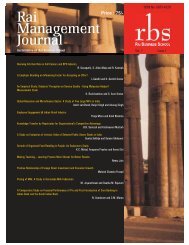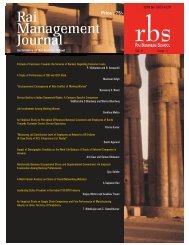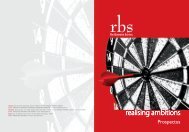Gas sector, to capture the movementof share price in the year 2009-2010,using the Run Test. The Indian Oiland Gas companies which wereselected for the analysis were Abanoffshore Ltd, Bharat Petrolieumcorporation Ltd, Cairn Ltd, Essar oilLtd, GAIL ,Indian oil, ONGC,Reliance Naturals Ltd and RelianceIndustries Ltd.LITERATURE REVIEWA Random Walk Down Wall Street,written by Burton Malkiel in 1973,has become a classic in investmentliterature. Random walk theory jibeswith the semi-strong efficienthypothesis in its assertion that it isimpossible to outperform the marketon a consistent basis. Malkiel putsboth technical analysis andfundamental analysis to the test andreasons that both are largely a wasteof time. In fact, he goes to greatlengths to show that there is no proofto suggest that either can consistentlyoutperform the market. Any successoutperforming the market withtechnical analysis or fundamentalanalysis can be attributed to ladyluck. If enough people try, some arebound to outperform the market, butmost are still likely to underperform.Many studies have been done on theEfficient Market Hypotheses,some ofthem are discussed here.Barnes (1986) examined 30companies and 6 sector indices for thesix years ended 30 June 1980. Usingmonthly data, the serial correlationand runs tests results exhibit a highdegree of efficiency in the weak form,with little departure from the randomwalk hypothesis. Further spectralanalysis confirms the earlier findingsthat the KLSE is fairly efficient.Laurence (1986) used daily closingprices adjusted for cash and stockdividends, splits and rights issues, of16 individual stocks traded on theKLSE over the sample period of 1June 1973 through 31 December 1978.Results from serial correlation andruns tests suggest only slightlydeviation from perfect weak-formefficiency. Using data for 6 sectorindices and the all-share index from1975 to 1982, Saw and Tan (1989)found that the Malaysian stockmarket is inefficient in the weak formwhen weakly data were used, butpockets of market efficiency existedwhen monthly data were used.Annuar et al. (1991) conducted theweak form test on 82 individual stockswhich were continuously traded onKLSE from 1975 to 1989, using theunit root methodology to account forcyclicality in price series andcontrolling thin trading effect.Overall, about 87% of the total sampleof 82 stocks possess unit root,implying that there is a 13% chancethat a security price is inefficient overthe fifteen-year period. Though thefindings suggest the market isgenerally weak form efficient, pocketsof inefficiency are observed for sharesthat suffer liquidity problem. Annuaret al. (1993) addressed similar issuebut using indices data in place ofindividual stocks, covering sampleperiod from January 1977 throughMay 1989, with weekly and monthlyintervals. The results from unit rootanalysis, serial correlation test and Qstatistics strongly suggest that theKLSE is weak form efficient, though,once again, pockets of inefficiency are[ 94 ] Rai Management Journal
eported forsome indices.Kok and Lee (1994) analyzed thestock prices behaviour of 32 companieslisted on the Second Board of KLSEover the period 2 January 1992 to 30December 1994. The results fromvarious statistical tests- runs test,serial correlation test, Ljung-Box-Pierce Q test and Von Neumann’sratio test, suggest that informationbased on historical prices is fullyreflected in current price within aweek but may not be fully impoundedin current price within a day. Thus,the Second Board of KLSE is weakformefficient with respect to weeklydata. Though daily price series areserially correlated, the magnitude oftheir correlations is not large enoughto devise any mechanical trading rulesfor profitable investment timing. Kokand Goh (1995) utilized daily, weeklyand monthly closing prices of 7 KLSEstock indices over a period of nineyears from 1984 to 1992. Using similarmethodologies as Kok and Lee(1994), the authors found serialdependencies in successive pricechanges for all KLSE daily stockindices. However, the significantcorrelations found are very small thatit is unlikely to have any economicvalue, and this led the authors toconclude the market is weak formefficient. When weekly data wereused, the efficiency of the Malaysianstock market has improved from aweak-form inefficient market in themid 1980s to a weak-form efficientmarket by the late 1980s and early1990s. Finally, the results frommonthly data provide conclusiveevidence of weak form efficiency,suggesting that market efficiencyimproves with longer temporalaggregation of sample data. Unlikeother studies, Kok and Goh (1995)proceeded to address the issue of meanreversion using long-horizon returns.Though the variance ratio testprovides evidence of mean reversion, itis not statistically significant to rejectthe long run random walk hypothesis.The evidence of non-linearity hasstrong implication on the weak-formEMH for it implies the potential ofpredictability in financial returns.Specifically, if investors could haveprofitably operated a trading rule (netof all transactions costs) that exploitsthis detected non-linearity, it would beat odds with the weak form EMH,which postulate that even non-linearcombinations of previous prices arenot useful predictors of future prices(Brooks, 1996; Brooks and Hinich,1999; McMillan and Speight, 2001).However, Hsieh (1989) argued that thestandard statistical tests such asserial correlation test, runs test,variance ratio test and unit root testsmay fail to detect non-linear departurefrom the random walk hypothesis.Motivated by this concern, Lim et al.(2003c) re-examined the random walkhypothesis as all those earlier KLSEstudies in favour of EMH haveimplicitly disregarded the presence ofnon-linearity, which will have seriousconsequences of making incorrectinferences and policyrecommendations, as highlighted byLiew et al. (2003). Using the Brock-Dechert-Scheinkman (BDS) test,which has been proven to be quitepowerful in detecting departures fromi.i.d. behaviour in some Monte Carlosimulations (see, for example, Brock etal., 1991; Hsieh, 1991)2, Lim et al.(2003c) found the inadequacy ofrandom walk model to describe theDecember 2010 Vol. 7, Issue 2[ 95 ]
- Page 1:
RaiManagementJournalAn Initiative o
- Page 4 and 5:
From the Editor’s DeskIt gives me
- Page 6 and 7:
Training Delivery and Methodology i
- Page 8 and 9:
The work force ofan organizationbec
- Page 10 and 11:
Choice of trainingand delivery meth
- Page 12 and 13:
Research studies ofmemory following
- Page 14 and 15:
Table -3: Perception of employees r
- Page 16:
Table -5: Perception of employees r
- Page 19 and 20:
Table -8: Perception of employees r
- Page 21 and 22:
Reference• Bhatia, S.K (1989).
- Page 23 and 24:
celebrity. Keeping these two things
- Page 25 and 26:
Figure IIFigure IIIDecember 2010 Vo
- Page 27 and 28:
• The Pepsi Campaign after theInd
- Page 29 and 30:
Table showing PERCENTAGE OF FAMILIA
- Page 31 and 32:
NAMETable showing PERCENTAGE OF Q-S
- Page 33 and 34:
and Irfan Pathan have beenranked at
- Page 35 and 36:
REFERENCESBOOKS -• Cloe, E. Kenne
- Page 37 and 38:
sations moving forward?In order to
- Page 39 and 40:
When studying the essentials of ano
- Page 41 and 42:
The effectiveness of the currentmot
- Page 43 and 44:
Fig.3: Ranking of Motivational Fact
- Page 46 and 47: It seems clear thatIndian organisat
- Page 48 and 49: • Kumar, N. (2001) Soft Ware Indu
- Page 51 and 52: table 1. On an average, restaurants
- Page 53 and 54: is also a major factor which effect
- Page 55 and 56: careful analysis of the market ands
- Page 57 and 58: Table 5: Size of the restaurants in
- Page 59 and 60: Table 12: Strategy for promoting re
- Page 62 and 63: ...there will be atextile boom inIn
- Page 64 and 65: apparel industry, be it export ordo
- Page 67 and 68: It is clear from table 5 that solep
- Page 69 and 70: Table 8: Ranking of various problem
- Page 71 and 72: It is evident from table 10 that th
- Page 73 and 74: Table 12 shows that the respondents
- Page 75 and 76: to more than 100 countries worldwid
- Page 77 and 78: An Empirical Study on Indian Health
- Page 79 and 80: Table-1: Gross Premium from Busines
- Page 81 and 82: On August 15, 2007, the PrimeMinist
- Page 83 and 84: data collected from the respondents
- Page 85 and 86: Profile, purpose and investingpract
- Page 87 and 88: The Percentage Rank Analysis isappl
- Page 89 and 90: Based on the Average PercentageAnal
- Page 91 and 92: OBJECTIVE-3:To study the factors th
- Page 93 and 94: FUTURE CHANGEEXPECTEDAt present whe
- Page 95: Random walks in stock market prices
- Page 99 and 100: SAMPLEFrom the list of Oil and Gas
- Page 101 and 102: • Barnes, P. (1986) Thin trading
- Page 103 and 104: Thus, this paper has incorporateddi
- Page 105 and 106: hypotheses of the information conte
- Page 107 and 108: The present study addresses itsobje
- Page 109 and 110: Deviations are similarly compared i
- Page 111 and 112: The remaining banks did not show an
- Page 113 and 114: at this time the Telecom sector had
- Page 115 and 116: constant dividend every year on the
- Page 118 and 119: Organized retail canbe defined as a
- Page 120 and 121: In the midst of the unorganised ret
- Page 122 and 123: convenience are some of majorattrib
- Page 124 and 125: STATISTICAL ANALYSESThe 475 usable
- Page 126 and 127: The Table 4 gives the 6 extracted f
- Page 128 and 129: The most significant factor thatdet
- Page 130 and 131: • Mulhern, F., and Leone, R., 199
- Page 132 and 133: carefully/exactly identified group
- Page 134 and 135: interaction effects. Variations in
- Page 136 and 137: eduction, indicating that the decli
- Page 138 and 139: Rs.10000 to Rs.20000 prefer maligai
- Page 140 and 141: Table 6: Reason for purchasing at a
- Page 142 and 143: Table 9: Monthly income and frequen
- Page 144 and 145: Once “time spent” by the users
- Page 146 and 147:
Out of 200 respondents 111responden
- Page 148 and 149:
etail stores are facing.VII. PREFER
- Page 150 and 151:
From table 22 it can be inferred th
- Page 152 and 153:
Role of Relationship in Pharmaceuti
- Page 154 and 155:
Wholesaler, animportantmiddleman fo
- Page 156 and 157:
... a medicalrepresentative needsto
- Page 158 and 159:
ole in selling the products. And74(
- Page 160 and 161:
On the Basis ofQualificationOut of
- Page 162 and 163:
Figure 7Figure 8[ 160 ] Rai Managem
- Page 164 and 165:
Empirical Study On PerformanceMeasu
- Page 166 and 167:
these non- productive assets wasalm
- Page 168 and 169:
Tools for Analysis:First of all the
- Page 170 and 171:
... the commonstrength of theplasti
- Page 172 and 173:
adversely. Thus the common problems
- Page 174 and 175:
• Nimbalkar .B. Chairman & Managi
- Page 176 and 177:
Customersatisfaction and theservice
- Page 178 and 179:
The tourismindustry of Indiahas exp
- Page 180 and 181:
The hotel industryof India is one o
- Page 182 and 183:
Reichheld and sche(2000) embracedth
- Page 184 and 185:
Customersatisfaction is verycrucial
- Page 186 and 187:
2010 and 2020 respectively whichcal
- Page 188 and 189:
• Zineldin, m. (1999), ``explorin
- Page 190:
RNI NO.: DELENG/2004/12383Printed a





